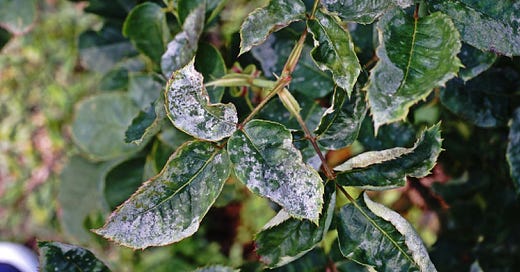POWDERY MILDEW -- That White Stuff on Your Plants' Leaves
Coming Soon to a Garden Very Near You
Powdery mildews are known by their spots or patches of white to grayish, talcum-powder-like growth on foliage, stems, and sometimes flowers. The symptom is the powdery mildew (or simply “mildew”); the causal organisms are some 700 species of fungi.
Several hundred species of plants, both ornamentals as well as edibles, serve as hosts to the various species of mildew-causing fungi. Conifers are untouched by mildews. Some of the most commonly affected plants:
ORNAMENTALS —
Aster
Birch
Black-eyed Susan
Cannabis
Clematis
Columbine
Crape myrtles
Delphinium
Dogwood
Goldenrod
Lilacs
Lupines
Maples
Monarda (bee balm)
Ninebark
Oak
Phlox
Roses
Sages
Sunflowers (the ornamental annuals and perennials)
Sycamore/planetree
Zinnia
EDIBLES —
Apples
Artichoke
Beans
Cucumbers
Eggplant
Grapes
Lettuce
Melons
Onions
Pears
Peas
Peppers
Pumpkins
Squashes
Strawberries
Sunflowers (the edible-seeded annuals)
Tomatillo
Tomatoes
The real standouts among these and the ones that are almost guaranteed to get some degree of mildew each year -- IF UNATTENDED -- are lilacs, roses, zinnia, cucumbers, grapes, melons, peas, and squash (including pumpkins).
Although many mildew-inducing fungi infect a wide-range of plants, most of these fungi species have their own lists of host species, usually plants of a single genus or a few plants within a family. For instance, the powdery mildew fungus that shows up on roses does not infect squash and vice versa. The species on maples doesn’t invade tomatoes nor bother zinnias. And so on. Special note: many cucurbits (squash, cukes, and melons) have leaves naturally marked with white veins that many mistake for mildew.
HERE’S WHAT GARDENERS REALLY NEED TO KNOW:
These fungi multiply when cool nights are followed by warm days. A “morning dew” appears on the leaves in the early hours and in this dew is where most powdery mildew species grow. Usually and interestingly, this happens during the droughty part of the year or anytime when soils have been allowed to go dry for too long. Cool nights + warm days + dry soil = powdery mildew.
Powdery mildew is not caused by “watering on top of the plants.” Counterintuitively, actually spraying the foliage off with the hose helps prevent the start of this fungi as well as helps minimize the damage and spread of already-started powdery mildew. Mildew spores die with too much water (“free water” on the leaf surface). Commercial rose growers often run their overhead watering systems during the summer. Along with washing off the potential start of a powdery mildew infection, this helps wash off the dust, which in turn helps to manage spider mites and a few other pests, as a bonus. When you do general watering, however you do it, always soak your garden soil well and deeply.
The mildew is at its worst when air circulation is reduced. So space plants fittingly and keep powdery-mildew-prone plants out from walls and fences (the “periphery syndrome,” whereby a design starts with planting things along the edges of the property and against the house, usually in minimally narrow strips). Plants under overhead canopies (trees, roof eaves) are also more prone to powdery mildew, both from diminished air circulation as well as from lack of rains that would otherwise wash off mildew spores. Woody shrubs and trees prone to mildew should be pruned/thinned to open them up to allow air to move through freely.
Powdery mildew also occurs most on plants that have been fed with nitrogen fertilizers. The softened tissue produced by such feeding allows the fungus to penetrate and spread more easily. (Such fast-growing new growth is also more attractive to aphids and other such sucking critters; forced new growth often cracks at the cell walls and that cracking releases volatile oils, which, in turn, provide the “runway lights” to the critters with the very tiny piercing mouthparts that need an easy way to get in.)
The spores of powdery mildew fungi are primarily air-borne but find settling spots during the off-season in plant debris, including vegetation left in place after harvest, winter leaf cover, and evergreen weeds around the property. If you’re a passive compost maker (simply piling waste up in piles with not much other action to maintain heat), it’s not a good idea to put diseased waste into the pile; better to dispose of it.
“Powdery mildew,” the visible symptom being the spores on top of the foliage, stems, flowers, grow and feed beneath the surface.
Once you get powdery mildew, there are some sprays that kinda work. Milk has shown some action on certain mildew species on certain plants, albeit an expensive program when a large garden is involved. A baking soda mixture works if applied correctly at the right stage in the mildew’s development. The commonly available Neem products no longer work as well for fungi as they once did. You can remove the most infected leaves but the more leaves you remove, the less overall strength the plant will have.
Keep the preventative measures in mind and you’ll minimize getting to this point; especially this last preventative point:
For many plants, including roses, crape myrtles, and most vegetables, there are cultivars and varieties within a type that are immune to or resistant to powdery mildew. Search those out; there are many. THIS is the real key.
© Copyright, Joe Seals, 2025






Thank you. Very interesting